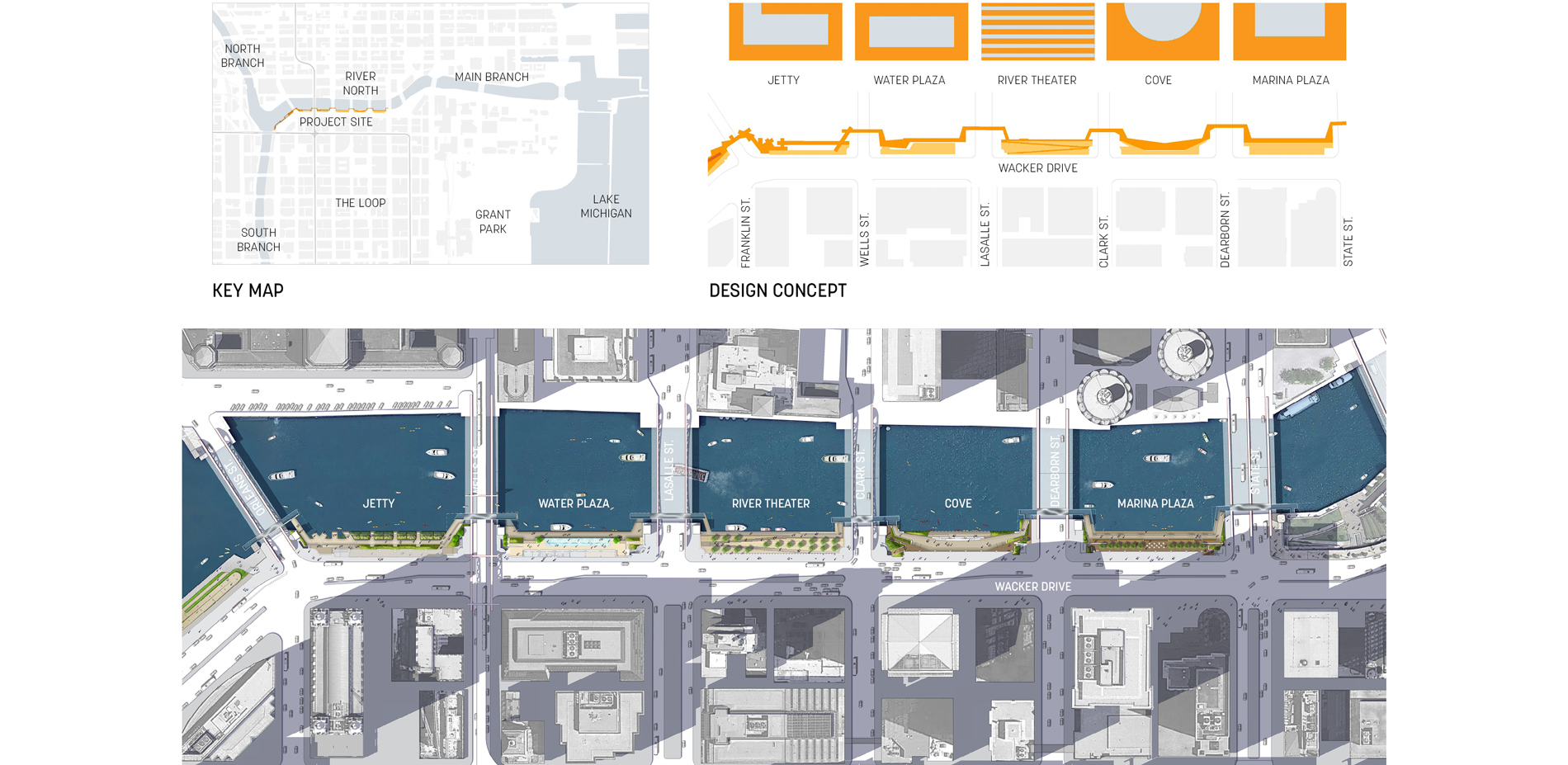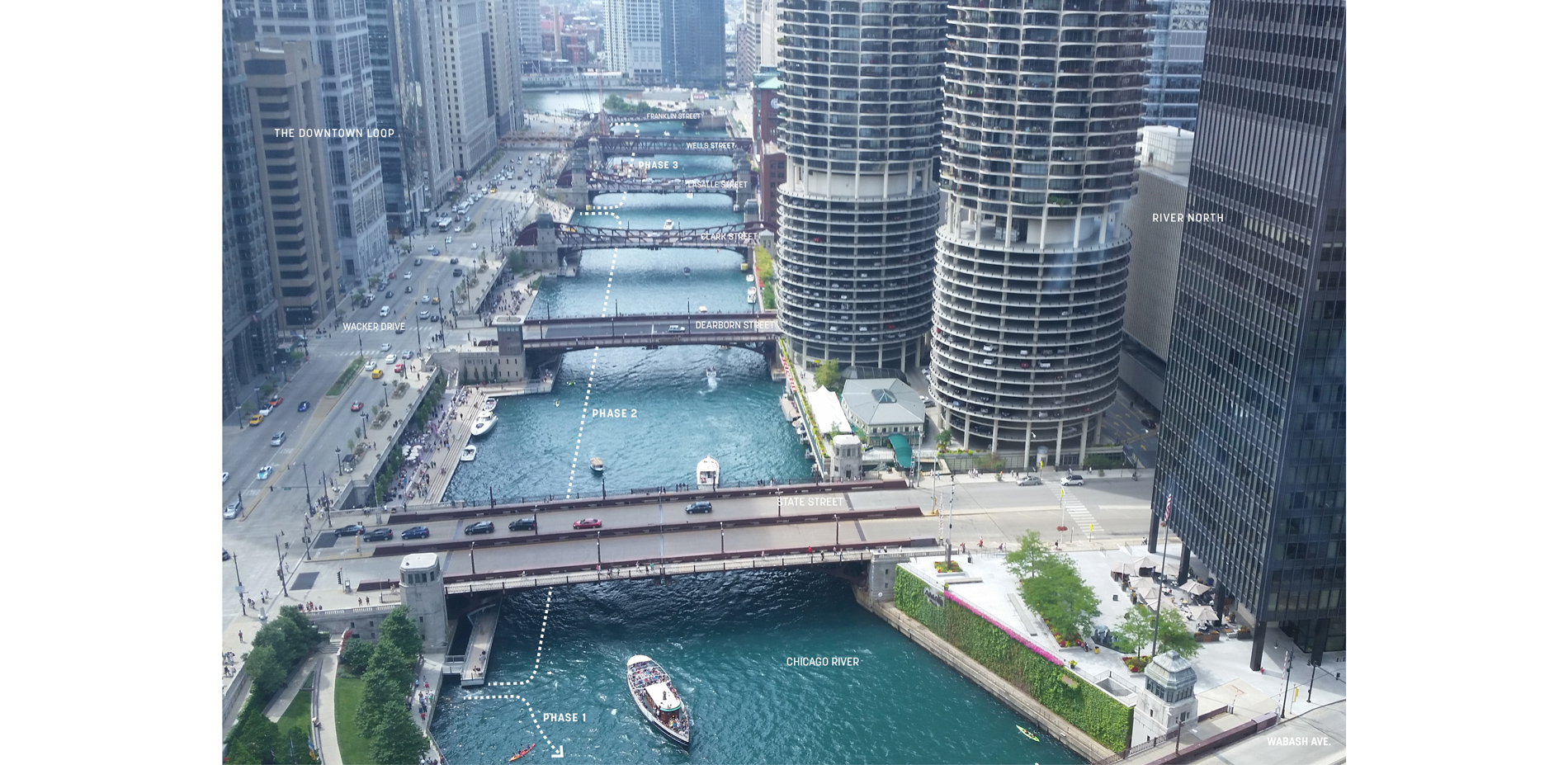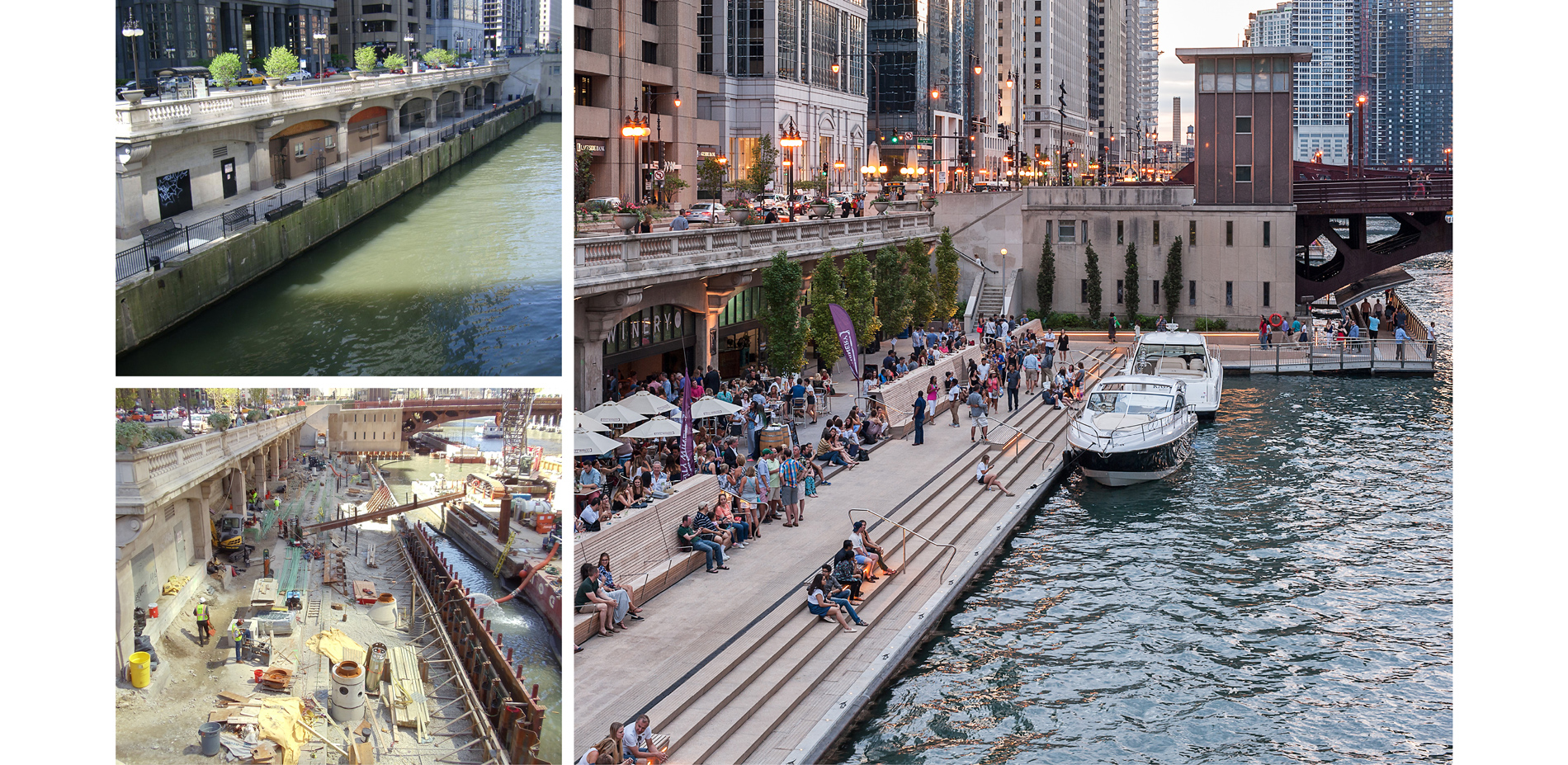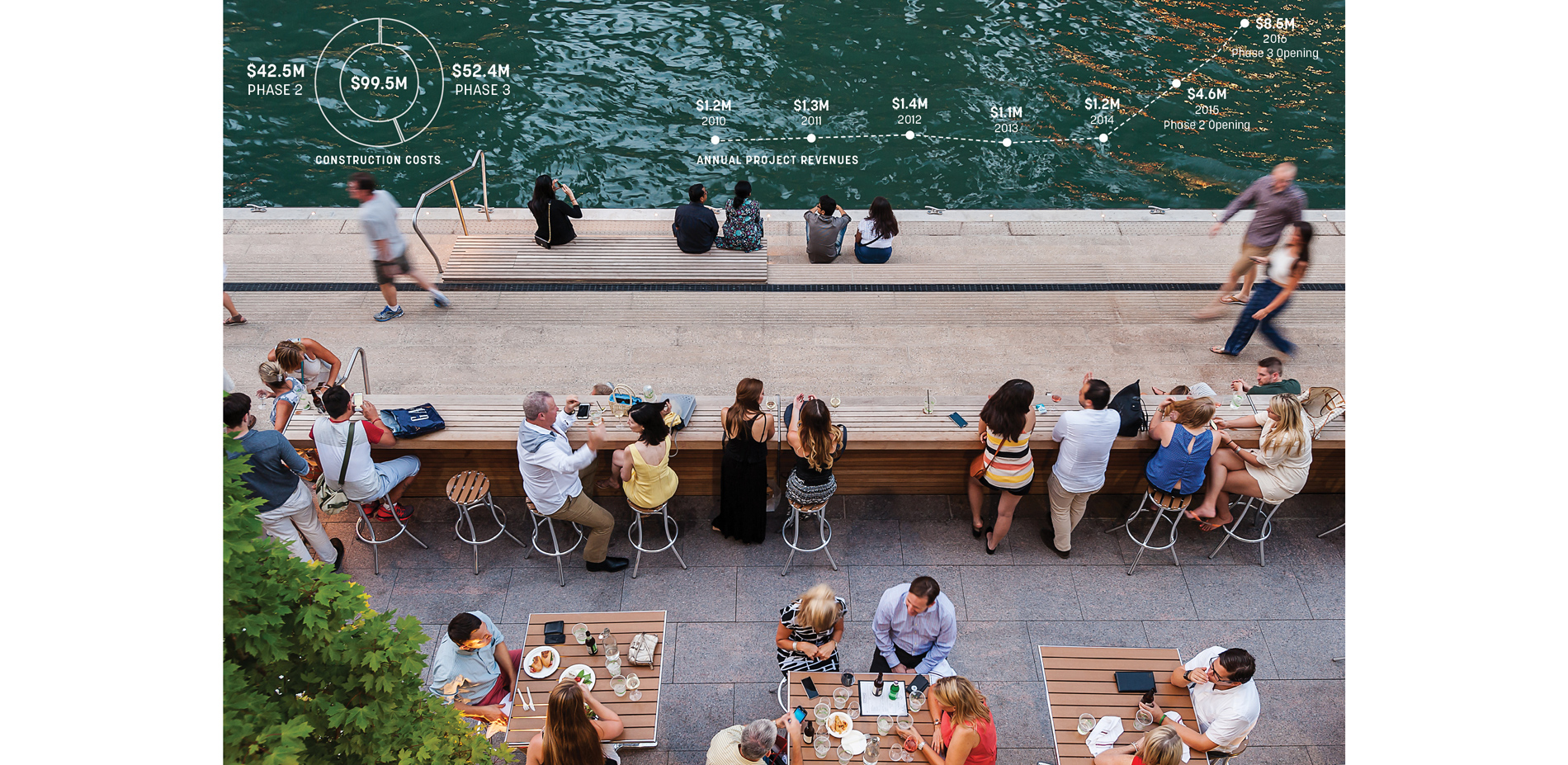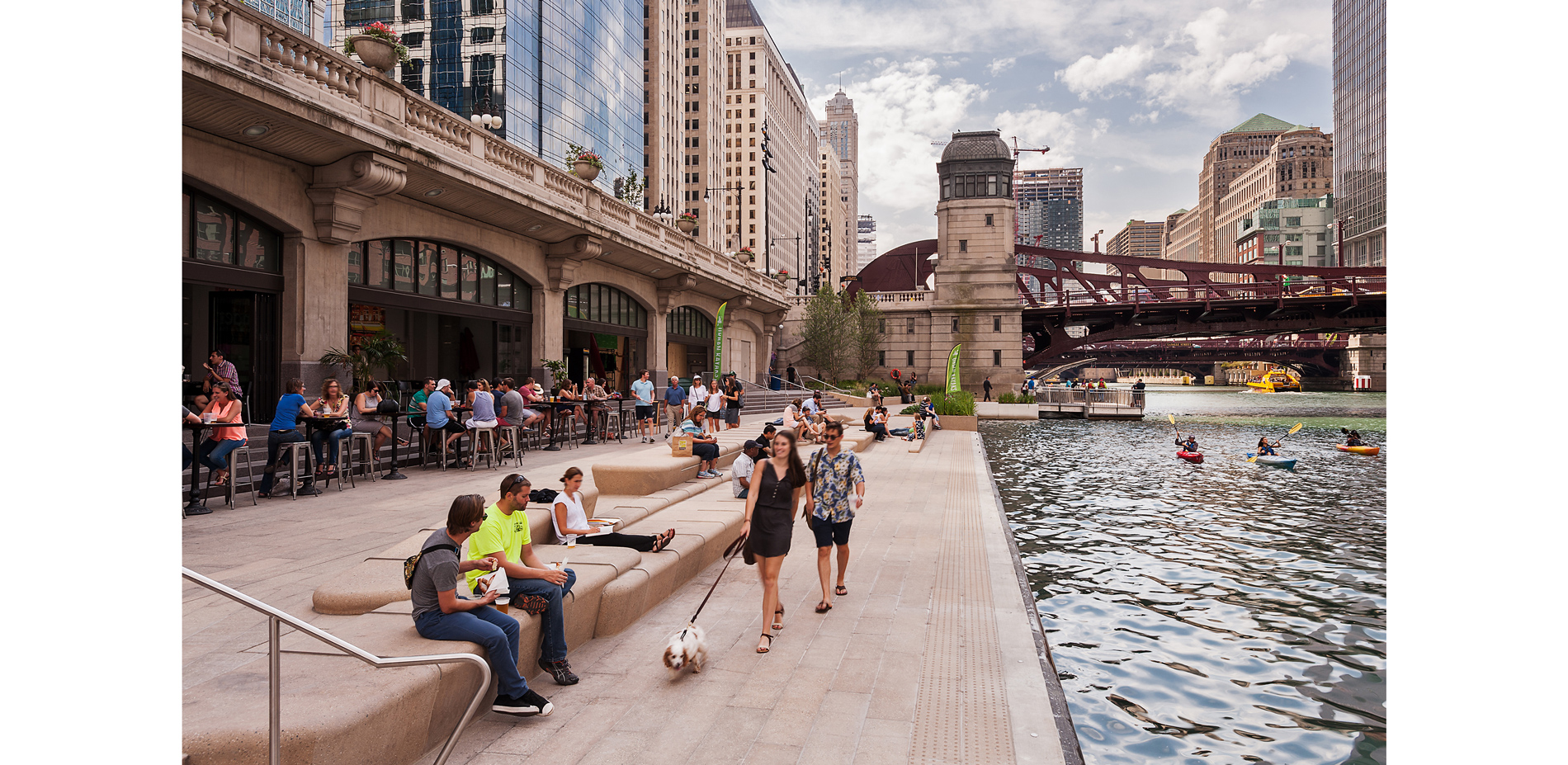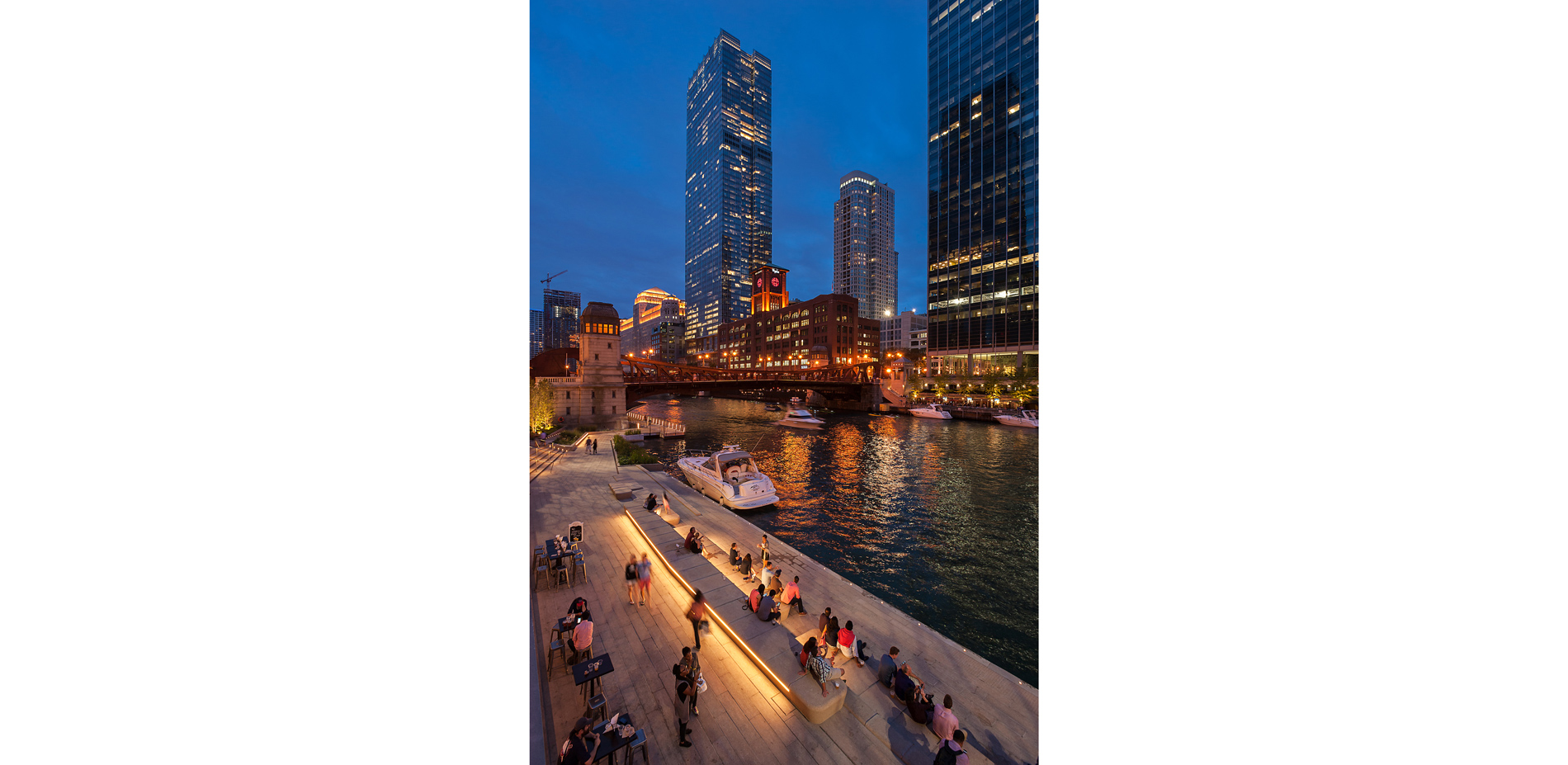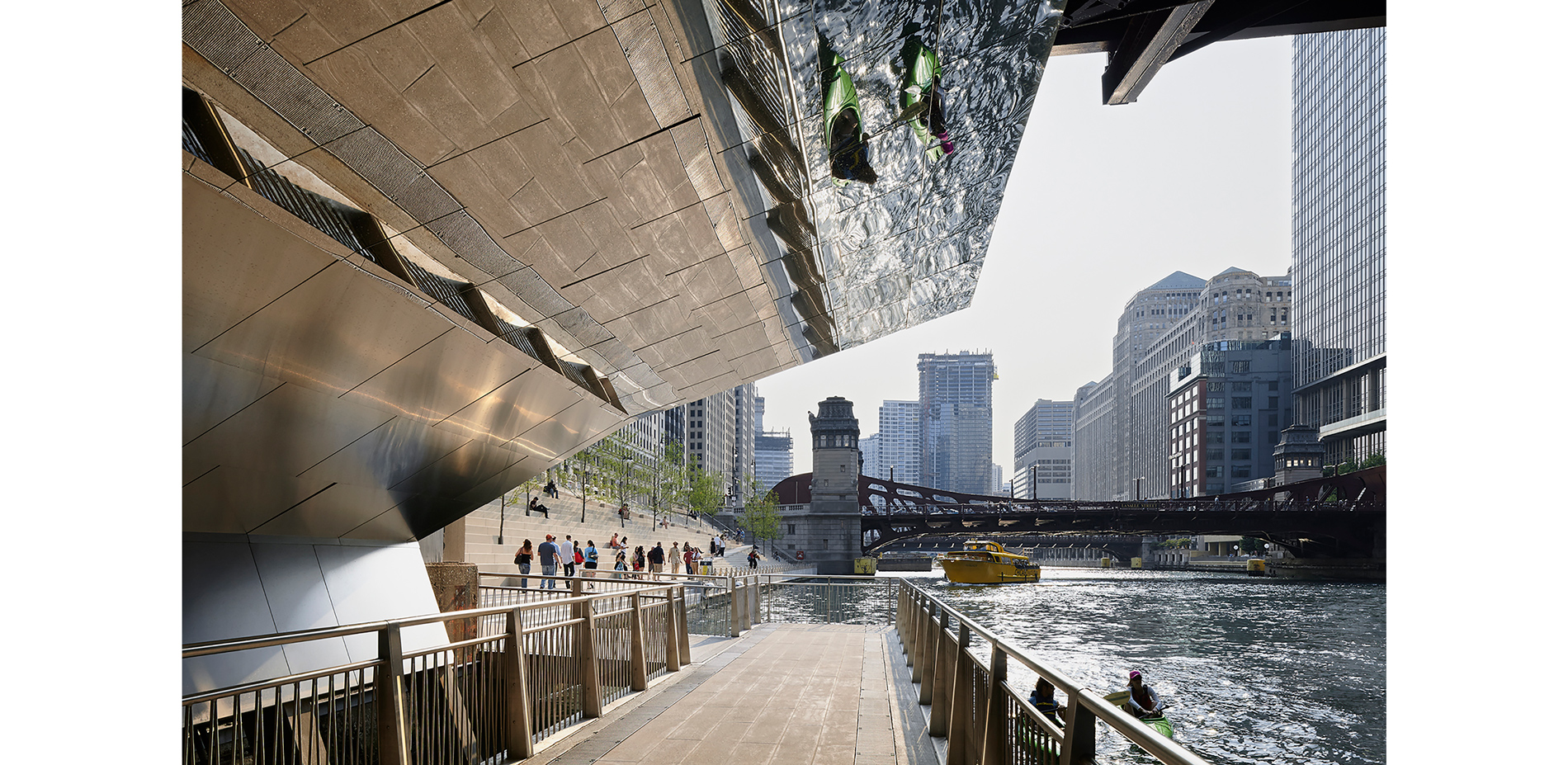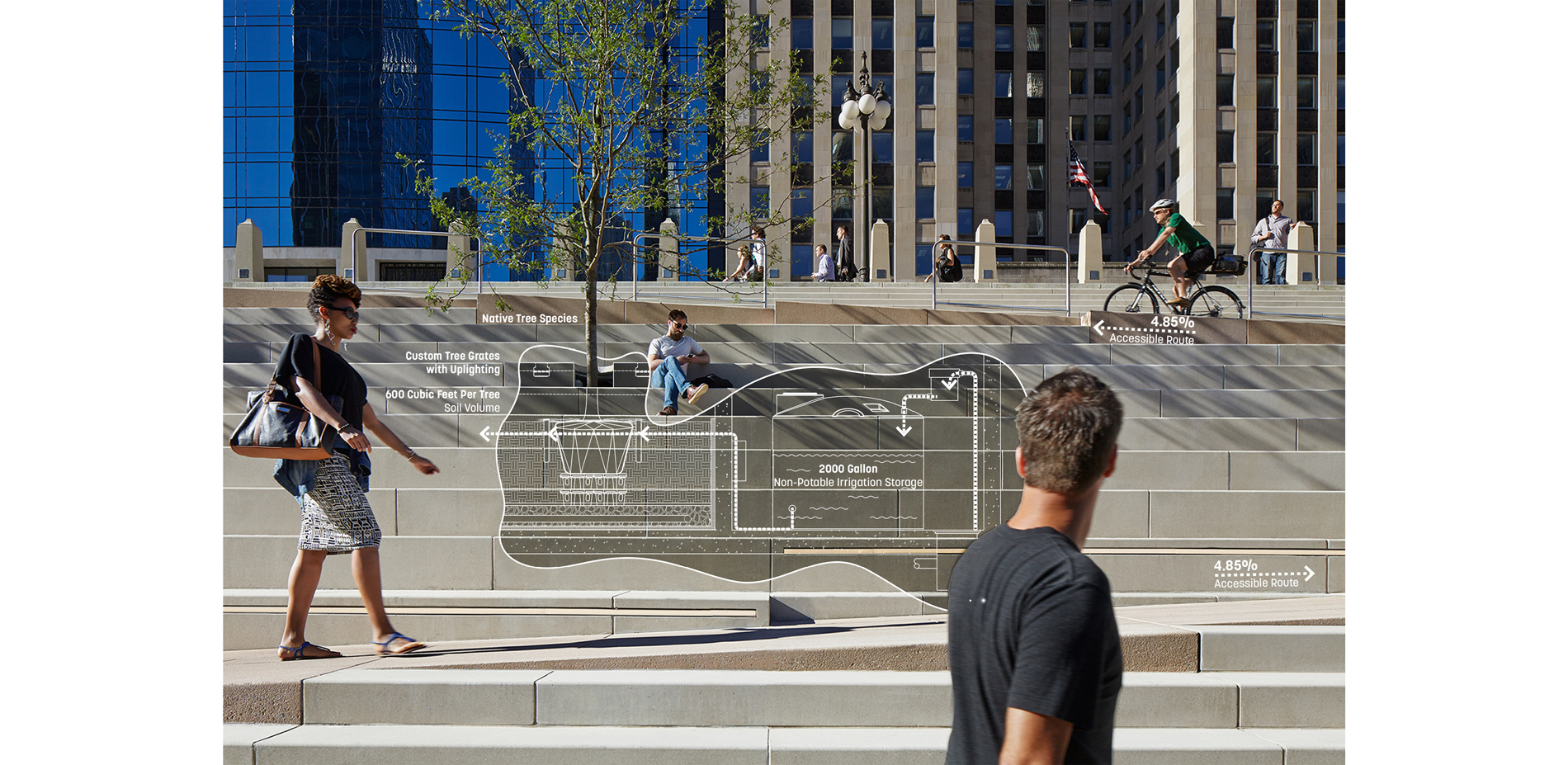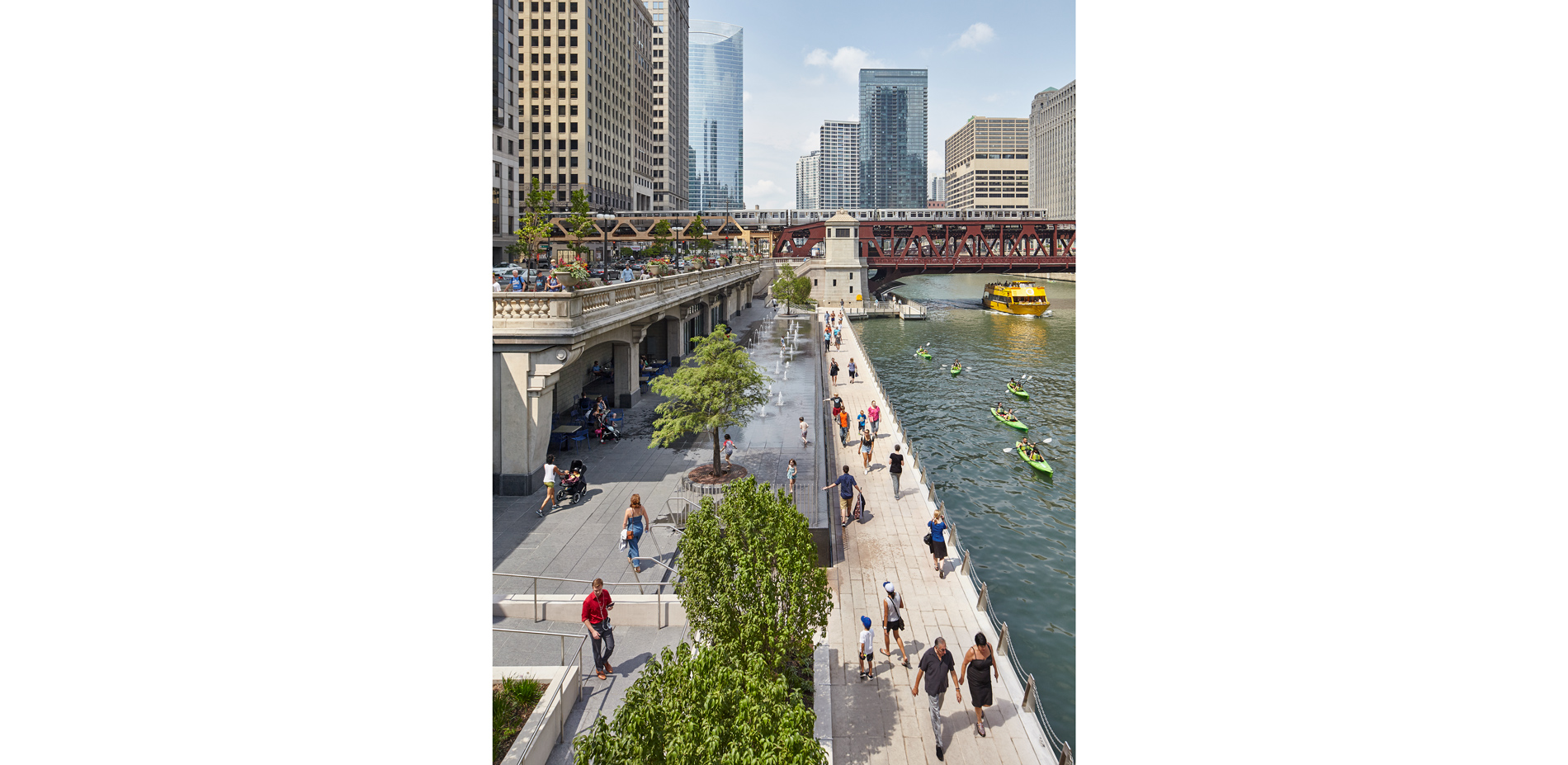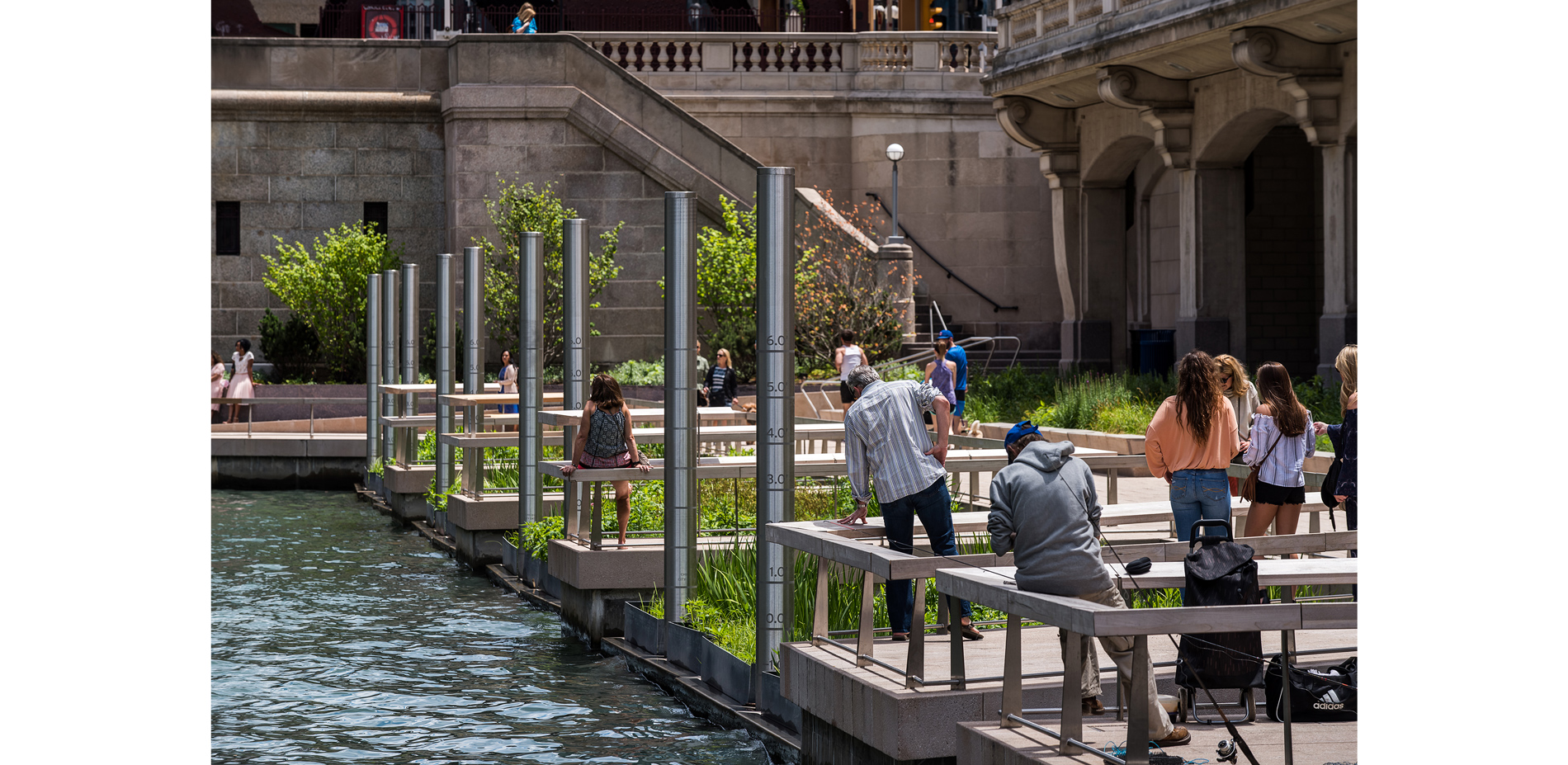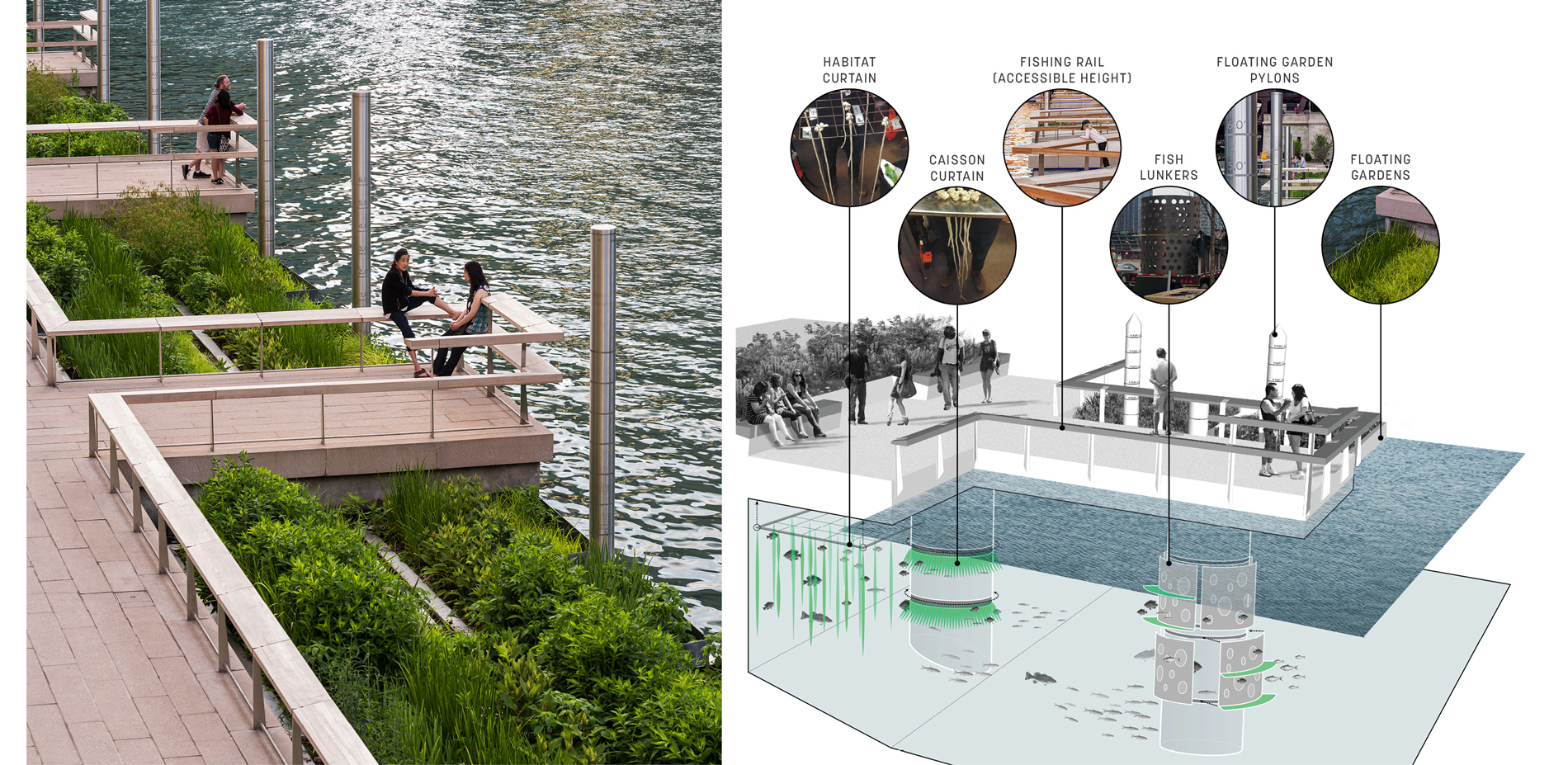Chicago Riverwalk | State Street to Franklin Street
HONOR AWARD
General Design
Chicago, IL, USA | Sasaki and Ross Barney Architects | Client: Chicago Department of Transportation
It was an extraordinary effort. When you see how it’s used, it becomes another pearl on the necklace that pulls you across the waterfront.
- 2018 Awards Jury
PROJECT CREDITS
Prime Consultant, Landscape Architect, Civil Engineer
- Sasaki
Architect
- Ross Barney Architects
Landscape Architect of Record/Firm
- Sasaki and Jacobs/Ryan Associates
Maritime Engineer
- Alfred Benesch Engineers
Local Landscape Architect
- Jacobs/Ryan Associates
Fountain Designer
- Fluidity Design Consultants
Contractor
- Walsh Construction Company
Local Civil Engineer
- Infrastructure Engineering Inc.
Lighting
- Schuler Shook
MEP Engineer
- Delta Engineering Inc.
Structural Engineer
- Rubinos & Mesia Engineers, Inc.
Surveying
- Dynasty Group, Inc.
Geotechnical Engineer
- GeoServices Inc.
PROJECT STATEMENT
The Chicago Riverwalk project, an initiative to reclaim the Chicago River for the ecological, recreational, and economic benefit of the city, is responsible for many realized and continuous river improvements over the past three decades. The segment between State Street and Lake Street represented the last unrealized and disconnected link between the lake and the river's confluence in the downtown core.
This five-block phase of the Riverwalk extension creates both unity and diversity—offering a continuous car-free environment that connects a series of distinct community spaces at the river's edge. The design demonstrates a technically complex implementation achievement, a creative adaptation of single-use transportation infrastructure for public benefit, an example of highly integrated sustainability, a flood-resilient urban landscape, and a vibrant addition to Chicago's growing body of extraordinary parks.
PROJECT NARRATIVE
From meandering stream to engineered channel to Burnham's civic promenade to reclaimed recreational resource, the Chicago River has a long and storied history that, in many ways, mirrors the development of Chicago itself. Until recently, the river's poor water quality and the public's perception of the river as an industrial conduit made the goal of embracing the river as a recreational amenity seem impossible.
But today, a growing downtown population, increasing recreational use on and along the river, and significant efforts to improve the river's environmental health city-wide have created the momentum for the river's reinvention. The Chicago Riverwalk project, an initiative to reclaim the Chicago River for the ecological, recreational, and economic benefit of the city, is responsible for many realized segments of continuous river improvements over the past three decades. The segment between State Street and Lake Street represented the last disconnected unrealized link between the lake and the river's confluence in the downtown core.
Design Vision
In 2012, the design team was tasked with completing the vision for Phases Two and Three: six blocks between State Street and Lake Street. Building off the previous studies of the river, the team's plans provide a pedestrian connection along the river between the lake and the river's confluence.
The project was a technically challenging task. The design team worked within a tight permit-mandated 25-foot-wide build-out area to expand the pedestrian program spaces and negotiate a series of underbridge connections between blocks. Further, the design had to account for the river's annual flood dynamics of nearly seven vertical feet.
Turning challenges into opportunities, the team reconceived the path as an independent system — one that, through changes in its shape and form, would drive a series of new programmatic connections to the river. Each block takes on the form and program of a different river-based typology:
The Marina Plaza offers a connected and well-proportioned series of people places — from the broad granite dining terrace to the intimate seating steps at the river's edge. Its custom-designed, high-backed teak benches offer a comfortable and elegant place to view the life of the river and the majestic architecture that lines the Main Branch.
The Cove, inspired by beach landscapes and the growing use of human-powered crafts, provides physical connections to the water through recreation. An open and sunny beach-like space, the Jetty is a place to pause for both for those walking the Riverwalk and those paddling along the river. Custom precast seating elements capitalize on the shallow grade changes and create sunny places for sitting near the river's edge.
The River Theater is a sculptural staircase linking Upper Wacker and the Riverwalk and offers pedestrian connectivity to the water's edge and seating, while trees provide greenery and shade. A fully-accessible geometric path, lined with dramatic LED lighting, is the central circulation feature. The stairs support staged events and provide a viewing platform of the theater of the river and city.
The Water Plaza provides an interactive water feature for engagement with water at the river's edge. The water creates a shallow pool that flows over a weir edge, delighting pedestrians along the Riverwalk path and providing year-round animation. The fountain's effects can be minimized to enable flexible use of the plaza or a low-flow cold weather feature.
The Jetty, a series of piers and floating wetland gardens, offers an interactive learning environment about the ecology of the river, including opportunities for fishing and identifying native plants. The custom railing is crafted of stainless steel and reclaimed teak and is designed predominantly at wheelchair accessible height (which is also great for perching!). The Jetty incorporates several innovative features — lunkers, hulas, and curtains — that provide a healthy habitat for the Chicago River's diverse native fish population.
The Riverbank, not included in this award submission, is the sixth block. This temporary landscape, fitted with basic marina and circulation infrastructure, anticipates future phases of design and construction.
Implementation
Construction of the first three blocks, from State Street to LaSalle Street, commenced in the winter of 2014 and opened in the summer of 2015. The second three blocks commenced in the summer of 2015 and opened in the fall of 2016. The completed project cost nearly $100 million and created a half-mile-long extension to the existing riverwalk.
The construction had to overcome significant complexities in addition to the traditional challenges associated with building landscapes. The construction was staged almost entirely from the river with many materials coming on and off site via barge. Construction had to allow for the active and perpetual use of all adjacent transportation routes, including the vehicles on the Wacker Drive Viaduct and bridges, and the diverse vessels on the river. Lastly, subsurface conditions — including active subway tunnels, complex utility infrastructure, and layered existing structural systems — required extensive choreography.
The realized outcomes proved the value of persistence. As a new connected path system, this six-block extension provides both continuity and variety for a visitor. As each block provides a unique experience to the visitor, the design simultaneously offers a clear and unified identity. Design materials, details, and repeated forms provide visual cohesion along the entire length of the project. Paving, for instance, mirrors the contrasts of the existing context: a refined cut stone follows the elegant Beaux-Arts Wacker viaduct and bridgehouse architecture, while a more rugged precast plank flanks the lower elevations and underside of the exposed steel bridges.
Lastly, the project realizes six underbridge crossings under the existing bridge desks at each block, connecting blocks that previously had been discrete spaces. These stainless-steel-canopied mini-bridges both shelter pedestrians as they pass beneath the bridge deck above and reflect the texture and light of the river's surface.
Design Innovations
This latest phase of the Riverwalk is embraced by users and critics as a successful and vibrant new place in a city known for its park design. Architectural critic Blair Kamin of the Chicago Tribune says, "The latest stretch of the Riverwalk marks a significant step forward in transforming the once-neglected downtown riverfront. Here, in bold strokes worthy of Daniel Burnham, Chicago is confirming and renewing its identity as a civilized metropolis."
More specifically, it also provides the following design innovations:
- Adaptive Reuse of Infrastructure: a model of successful repositioning of an underutilized and single-use piece of transportation infrastructure
- Creation of Mobility Choices: the creation of 1/2 mile of new car-free pedestrian, bicycle, and boating infrastructure
- Technical Excellence: a technically-complex achievement both at the engineering scale and the scale of landscape detailing. Craft, form, precision, proportion, and material all contribute to the project's success
- A Dynamic Edge: the lowered and barrier-free structural edge enables boats to temporarily dock while also allowing visitors to directly engage with the water's edge
- Activation of Public Space: the active, passive, and seasonal programming of the space is enabled by the design's built-in diversity and flexibility
- Integrated Sustainability: long-term tree health is supported project-wide with structural paving systems to enable the appropriate soil volumes and irrigation using reclaimed stormwater
- Innovative Funding: the project is a new model for realizing a significant capital improvement project, funded by a federal transportation grant which will be repaid with revenues from the project
- A Flood-Resilient Landscape: with paving, planting, and lighting systems designed for periodic flood inundation, the Riverwalk demonstrated its resilience just weeks after opening when it flooded, and was cleaned and reopened within 12 hours of the waters subsiding
- Ecological Health: the Jetty's fish infrastructure provides a new model for addressing traditional marine edges in a way that enables greater habitat — it is actively being monitored and evaluated for expansion consideration
PRODUCTS
Product Sources: SOILS
- Local planting soil source in coordination with Christy Webber
Product Sources: HARDSCAPE
- Coldspring - Granite
- Architectural Cast Stone - Precast Phase 2
- Wausau Tile - Precast Phase 3
Product Sources: LIGHTING
- BEGA Kenall
- LED Linear Hydrel
- ETC
- Grupo MCIWinona LED
- Solavanti Lighting
- Crystal Fountains
- Designplan Lighting
Product Sources: FURNITURE
- Chicago Ornamental Iron - Custom benches
- Architectural Cast Stone - Precast Seating - Phase 2
- Wausau Tile - Precast Seating - Phase 3
Product Sources: DRAINAGE
- ACO Trench Drains - Phase 2
- ABT Slot Drains - Phase 3
Product Sources: FENCE/GATES
- Chicago Ornamental Iron - Guardrails
- Architectural Cast Stone - Precast Walls - Phase 2
- Wausau Tile - Precast Walls - Phase 3
Product Sources: IRRIGATION
- Rainbird
Product Sources: LUMBER/DECKING
- East Teak - Marina Bench - Phase 2
- East Teak - Jetty Bench - Phase 3
- Global Teak - Jetty Fishing Rail - Phase 3
Product Sources: STRUCTURES
- Chicago Ornamental Iron
Product Sources: WATER MANAGEMENT
- Wahaso Rainwater Harvesting System
- Crystal Fountains - WN-01 - Frothy jets in Water Plaza
- Crystal Fountains - WN-02 - Smooth bore arching jets in Water Plaza
